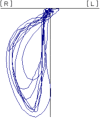Masticatory movements and food textures in older patients with eating difficulties
- PMID: 34676589
- PMCID: PMC9297966
- DOI: 10.1111/ger.12596
Masticatory movements and food textures in older patients with eating difficulties
Abstract
Objectives: To investigate whether masticatory movements in older patients with eating difficulties were associated with oral motor function, physical function, and appropriate food textures.
Background: There are few reports on the association between masticatory movements and food textures in older patients with eating difficulties.
Materials and methods: This cross-sectional study involved outpatients at a clinic that specialised in eating and swallowing rehabilitation. Masticatory movements were evaluated as normal or abnormal masticatory path patterns. Oral and physical functions were assessed in terms of oral and physical status, muscle strength and motor skills. The appropriate food texture was determined based on fibreoptic endoscopic evaluation of swallowing and a video fluoroscopic swallowing study. The associations between food texture and masticatory organ, muscle strength and motor skills were analysed.
Results: A total of 126 outpatients (75 men and 51 women; mean age, 78.2 years; SD, 9.6 years) were included in the analysis. 68 participants (54.0%) showed abnormal masticatory movements. Masticatory movement was associated with masticatory performance (odds ratio [OR] = 0.99, 95% confidence interval [CI] = 0.98-0.99), oral diadochokinesis (OR = 0.55, CI = 0.35-0.86) and stepping test (OR = 0.92, CI = 0.86-0.97). Masticatory movement (OR = 2.94, CI = 1.23-7.01) and the number of natural teeth (OR = 0.94, CI = 0.89-0.99) were associated with normal food.
Conclusion: Masticatory movements in older patients with eating difficulties may be associated with appropriate food textures whilst being influenced by individual differences in systemic motor control. Masticatory movements may be as important as teeth to enjoy eating.
Keywords: appropriate food; elderly people; jaw movement; masticatory function; oral motor function.
© 2021 The Nippon Dental University. Gerodontology published by Gerodontology Association and John Wiley & Sons Ltd.
Conflict of interest statement
The authors declare no conflict of interest.
Figures
Similar articles
-
Association between masticatory movement and oral and physical function in healthy older women.J Prosthodont Res. 2022 Jul 30;66(3):416-421. doi: 10.2186/jpr.JPR_D_20_00285. Epub 2021 Nov 18. J Prosthodont Res. 2022. PMID: 34789608
-
Relationship between subjective masticatory performance assessed by food acceptance questionnaire and comprehensively assessed oral function in older outpatients at a dental hospital in Japan: a cross-sectional study.BMC Oral Health. 2025 Jan 31;25(1):169. doi: 10.1186/s12903-025-05534-0. BMC Oral Health. 2025. PMID: 39891092 Free PMC article.
-
Factors influencing eating ability of old in-patients in a rehabilitation hospital in Japan.Gerodontology. 2003 Jul;20(1):24-31. doi: 10.1111/j.1741-2358.2003.00024.x. Gerodontology. 2003. PMID: 12926748 Clinical Trial.
-
Oral physiology and mastication.Physiol Behav. 2006 Aug 30;89(1):22-7. doi: 10.1016/j.physbeh.2006.01.025. Epub 2006 Mar 29. Physiol Behav. 2006. PMID: 16564557 Review.
-
Mastication and swallowing: an overview.Br Dent J. 1992 Oct 10;173(6):197-206. doi: 10.1038/sj.bdj.4808002. Br Dent J. 1992. PMID: 1389633 Review.
Cited by
-
Age-group-specific association of oral health and systemic health on cognitive function: a cross-sectional study of Korean elders.BMC Oral Health. 2023 Dec 13;23(1):997. doi: 10.1186/s12903-023-03724-2. BMC Oral Health. 2023. PMID: 38093280 Free PMC article.
-
Masticatory performance of unilateral chewing and free chewing.Odontology. 2025 Apr 24. doi: 10.1007/s10266-025-01102-8. Online ahead of print. Odontology. 2025. PMID: 40272758
-
Kinematic Features of Mandibular Movement during Mastication in Geriatric Individuals Who Are Provided with a Dysphagia Diet at Long-Term Care Facilities.Nutrients. 2023 May 11;15(10):2273. doi: 10.3390/nu15102273. Nutrients. 2023. PMID: 37242156 Free PMC article.
-
Capturing Eating Behavior from Video Analysis: A Systematic Review.Nutrients. 2022 Nov 16;14(22):4847. doi: 10.3390/nu14224847. Nutrients. 2022. PMID: 36432533 Free PMC article.
References
-
- Sheiham A, Steele JG, Marcenes W, et al. The relationship among dental status, nutrient intake, and nutritional status in older people. J Dent Res. 2001;80(2):408‐413. - PubMed
-
- Jensen GL, Mirtallo J, Compher C, et al. Adult starvation and disease‐related malnutrition: a proposal for etiology‐based diagnosis in the clinical practice setting from the international consensus guideline committee. J Parenter Enteral Nutr. 2010;34(2):156‐159. - PubMed
MeSH terms
LinkOut - more resources
Full Text Sources



